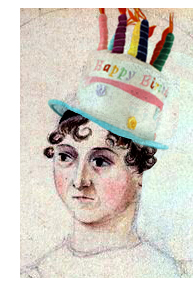| Sun | Mon | Tue | Wed | Thu | Fri | Sat |
|---|---|---|---|---|---|---|
| 1 | 2 | 3 | 4 | 5 | ||
| 6 | 7 | 8 | 9 | 10 | 11 | 12 |
| 13 | 14 | 15 | 16 | 17 | 18 | 19 |
| 20 | 21 | 22 | 23 | 24 | 25 | 26 |
| 27 | 28 | 29 | 30 | 31 |
CATEGORIES
RECENT ENTRIES
BLOG ROLL
235 birthdays
 The Jane Austen Society of North America celebrates Jane Austen’s birthday.
The Jane Austen Society of North America celebrates Jane Austen’s birthday.
On December 16, 2010, Jane Austen would have been 235 years old. Despite her 17th-century sensibilities, Austen’s many novels still hold enough relevance to inspire some kind of movie or book every few years or so. Her true fans, though, remain dedicated to her unadulterated writing: the Jane Austen Society of North America, for example, has about 4,000 members around the country. And every December the society celebrates the novelist’s birth.
The Greater Chicago chapter honored the occasion December 4 with an afternoon tea at the Fortnightly of Chicago, founded in 1873 (many of its founders and early members were University of Chicago faculty wives). The space was limited, so the only way to go to the tea was to (a) be a member, or (b) be invited by a member. I met my member-host, Becky Dolin, at a chocolate-making class a few months ago. We (of course) started talking about the University of Chicago—she earned a certificate from the Graham School’s Basic Program—and, next thing I knew, we were talking about Austen. Always a fan, Dolin became a full-fledged Janeite after taking a class with Elisabeth Lenckos, Basic Program instructor and the society’s program director.
The tea, which drew about 140 guests on a snowy Sunday, featured Basic Program chair Michaelangelo “Michael” Allocca as the keynote speaker. “Listening to people say so many great things about me,” he said after being introduced by a former student, “I almost feel like Lady Catherine de Bourgh, but I think the people here really mean it.” He spoke on “Austen’s Degrees of Disagreeability,” inspired by a section in Northanger Abbey (1818), in which Isabella Thorpe recommends a selection of “Horrid Novels,” seven works of Gothic fiction, to Catherine Morland. “Are you sure they are all horrid?” Catherine asks. Horrid, a word used often in that novel, has multiple meanings: it’s a good qualifier in the sense used above, when the goal is to be “horrid,” or frightening, but in other places, it means “terrible.”
Many of Austen’s characters, Allocca said, are assigned into categories of good and bad based on snap judgments. Sometimes they’re right for the wrong reasons, and other times they’re just wrong. In Sense and Sensibility, for example, he said, most of the time the characters are “quite the reverse” of what we assign them to be. With the charming and handsome John Willoughby, he appears at first to be a good man, but, by the end, he’s discovered to be a lying, conniving villain. When he’s apologizing to Marianne on her sickbed, he uses the word “horrid” to describe himself four times in a single page—"the most prominent reappearance of the word," Allocca said—all with different meanings, but none of those is a compliment.
But the tea wasn’t all history and literary criticism: the final event of the afternoon was a raffle of Austen-related items. And my host, Dolin, won a graphic-novel version of Sense and Sensibility. The book—not the graphic novel—celebrates a birthday of its own this year: its 200th.
Ruth E. Kott, AM’07
December 17, 2010
